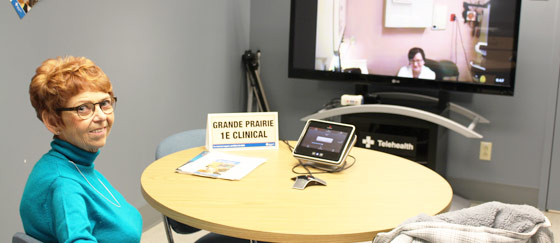
December 2, 2015

Thanks to Telehealth, Ann Jamieson in Grande Prairie is able to meet with Nurse Debra Ney at the Renal Insufficiency Clinic, all without the hassle and expense of travelling to Edmonton.
Story by: Sara Warr
A five hour trip to Edmonton in the dead of winter for a 15-minute routine appointment is a thing of the past for Ann Jamieson, and many others.
“My doctor doesn’t feel like I need to see her face-to-face when we can do it over videoconference,” says Jamieson, who lives in Grande Prairie.
Diagnosed with poor kidney function five years ago, Jamieson initially made the five-hour drive to her appointments at the Alberta Health Services (AHS) Renal Insufficiency Clinic in Edmonton, until her care team recommended meeting via Telehealth videoconference instead.
“The big thing was the cost and time for travel,” she says. “If I go to Edmonton it has to be overnight, because I get tired really fast. Fuel, food, hotel room - it can cost anywhere between $500-1000.”
The clinic, offered through AHS’ Northern Alberta Renal Program (NARP), often uses Telehealth to connect with patients who don’t live near Edmonton or Calgary.
“We do well over 1000 Telehealth visits per year through our U of A clinic alone,” explains Janice McKenzie, Unit Manager for NARP. “Depending on what their level of kidney function is, we might want to see them once a month or every three months. The travel can be quite a burden, particularly during the winter with poor road conditions.”
Telehealth has been used in clinical settings for more than a decade. As Judy Treppel, Provincial Manager for Clinical Telehealth with AHS explains, more programs and departments are incorporating Telehealth into their daily practice all the time.
“We work with a wide variety of clinical programs to look at ways they can adopt Telehealth. Mental health, nephrology, neurology, pediatrics, pulmonary and cardiology programs are a few of the clinical programs that are using Telehealth. Patients are starting to ask clinicians if their appointment could be held by Telehealth rather than traveling into the city,” says Treppel.
Approximately 37,000 patients received care through Telehealth in AHS’ 2014/2015 fiscal year alone. Telehealth is not a replacement for face-to-face appointments, but rather an alternative method for patients to receive timely care, says Treppel.
“The specialist or clinician is responsible for determining if the appointment can be held over Telehealth, and this depends on what the clinician or specialist requires during the appointment,” she explains. “There may be specific reasons why Telehealth may not be possible. Types of Telehealth sessions can include consultations; follow up appointments and even family visits connecting families who have been separated due to hospitalization.”
But for many patients and clinicians, like Jamieson and her care team at the Renal Insufficiency Clinic, it’s a perfect fit.
“The sort of metabolic issues that people with kidney disease deal with are mostly things that show up in blood work,” explains McKenzie. “We’ll review blood work with them and do an assessment, which is easily done over Telehealth. It’s made our care so much easier in many ways; we love it.”
“I feel just as comfortable having the appointments through Telehealth as in-person,” adds Jamieson. “They’re right there on the screen, they can see me and my colouring. The appointments are almost identical. We go over the same thing, in the same order - how I’m feeling, my prescriptions and my medication list - it’s like I’m in the room with them.”
Unlike Skype or FaceTime, Telehealth sessions provide help over a secure connection, ensuring patient confidentiality is protected. For more information, or to see if Telehealth is right for you, ask your healthcare provider.